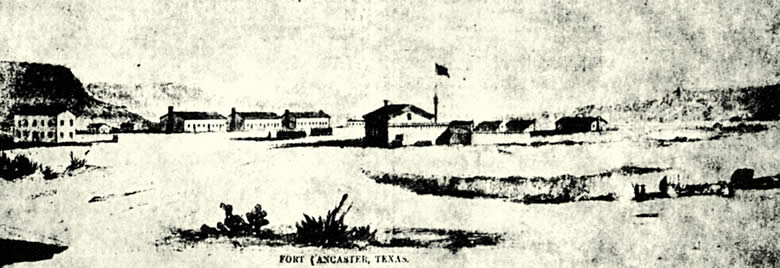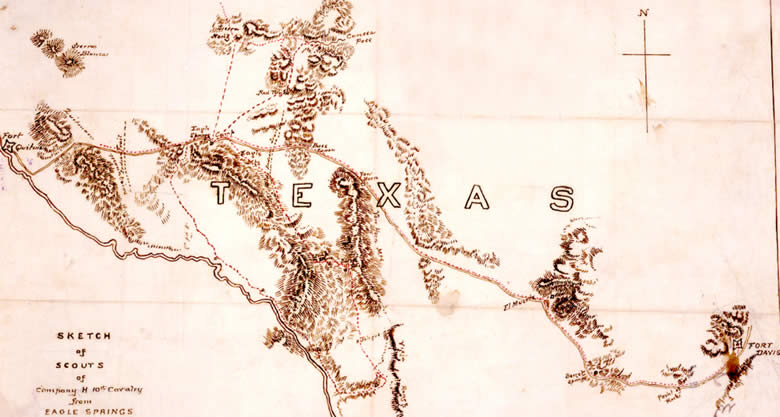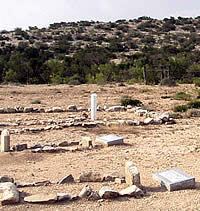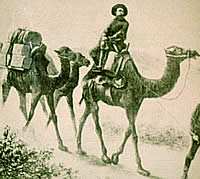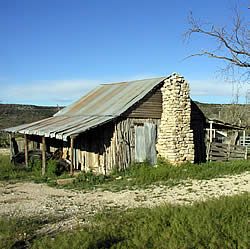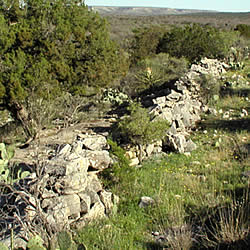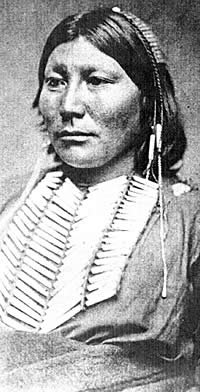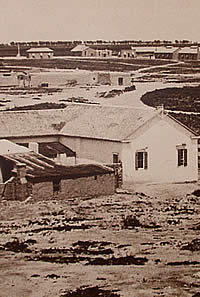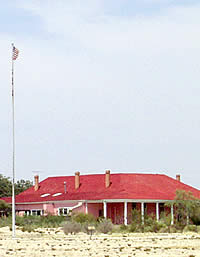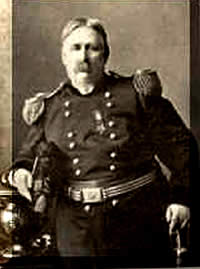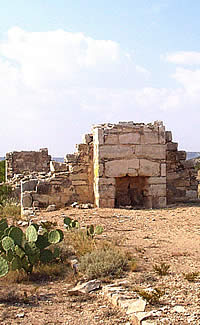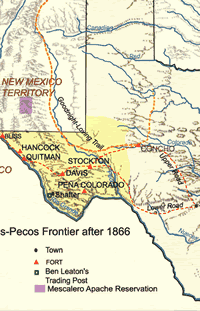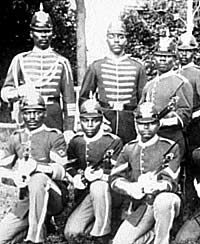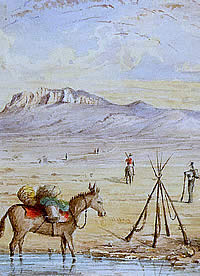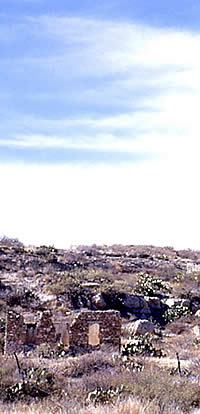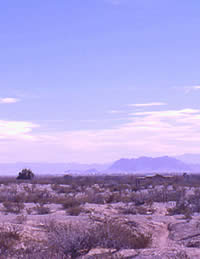
The dusty, flat landscape of the
Trans-Pecos is broken abruptly by mountains such as
the Chisos, Chinati, Glass, and Davis rising high above
the desert floor. This scene is in Presidio County,
near the Rio Grande. TARL Archives.
|
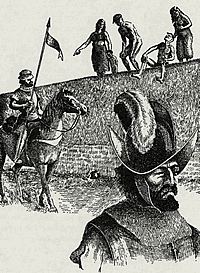
Jumano Indians standing atop the
walls of their pueblo watch the arrival of Spanish explorers.
According to explorer Hernán Gallegos, who traveled
the Trans-Pecos near La Junta in 1581, the early farmers
greeted them with "great merriment." Drawing
by Hal Story (Newcomb 1961).
|

Scene near La Junta de Los Rios, Presidio County, Texas.
Photo from TARL Archives (Presidio C-15). |
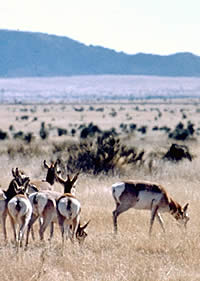
Pronghorn grazing in grasslands in far West Texas. Photo
courtesy Texas Parks and Wildlife. |
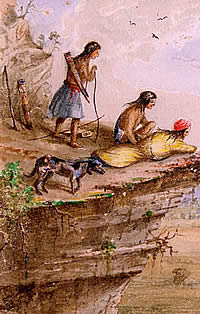
From a high overlook, Indians keep
a watchful eye on a caravan of travelers trudging through
a Trans-Pecos basin in far west Texas. "Comanche
Lookout" was painted in the mid- to late 1850s
by Capt. Arthur T. Lee, who was captivated by the aboriginal
peoples and stunning scenery near Fort Davis. Image
courtesy of the Rochester Historical Society.
|

Routes of Comanche trails from villages on the Plains.
Adapted from Weber 1982. |
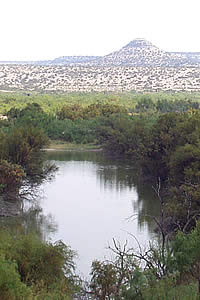
Pecos River crossing near Fort Lancaster. Photo by Susan Dial. |
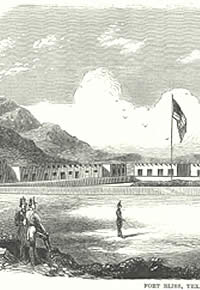
Fort Bliss, Texas. Established as a camp in 1849, it was
relocated to its present position in what is now El Paso.
|
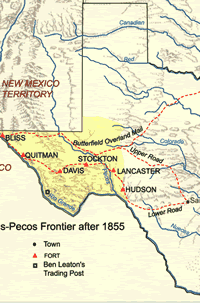
The Trans-Pecos frontier after 1855
and prior to the Civil War.
|
|
Much of the history of the Trans-Pecos region
of southwestern Texas has been of peoples on their way to
some place else. The Spanish mostly went around it. Comanche
and Kiowa raiders rode through it from the north on their
way to Mexico. Anglo-Americans came from the east, headed
for the California gold fields and western cattle markets.
In time, the travelers and their trails drew the attention
of the United States Army.
Prehistoric peoples lived and traded along
the middle Rio Grande—named El Rio del Norte by the Spanish—for
thousands of years before the arrival of Europeans. In 1535,
the wandering Alvar Nunez Cabeza de Vaca found Jumano and
other native groups farming the land at the junction of the
Rio Grande and the Rio Conchos—la junta de los rios—opposite
the site of modern Presidio, Texas.
Two Spanish exploratory expeditions in the early
1580s came down the Conchos, passed through la junta, turned
northwest, and followed the Norte toward its upper reaches.
In 1598, Juan de Oñate was authorized to settle the
lands within the modern boundaries of New Mexico. He traveled
over the Chihuahuan plateau to reach the Rio Grande some 150
miles upstream from la junta, and memorialized his crossing
of the river as El Paso del Rio del Norte. He then followed
the river to the pueblos of the north, where he settled his
colonists and established the town of Santa Fe.
Oñate found the Puebloans trading with
Plains Indians who brought buffalo robes to exchange for corn
and other agricultural products. The outlanders—the Spanish
called them vaqueros because of their trade in "cow"
hides—were the Plains Apache. The center of this trade
was the Pecos Pueblo, across the mountains to the east of
Santa Fe and near the headwaters of the Pecos River.
The province of Nuevo Mexico grew steadily,
if somewhat slowly, but the harshness of a succession of Spanish
governors led to an Indian revolt in 1680. The Spaniards withdrew
to the south and took refuge near Oñate's crossing
of the Rio Grande. Their northward advance stymied, the Spanish
began to dig in along the middle stretch of the river and
to establish missions at the Paso del Norte and la junta.
These missions remained after the Spanish returned to Santa
Fe. In 1760, the Spanish would establish Presidio de la junta
de los Rios Norte y los Conchos—known more simply in
later years as Presidio del Norte—to protect the missions
at the junction of the Rio Grande and Rio Conchos.
The missionary efforts at la junta were plagued
by Spanish slavers who captured local Indians and carried
them south to work in the silver mines. Apaches who visited
the Puebloans of New Mexico likewise were periodically abducted
by the Spanish and transported to the interior of Mexico.
When Comanches began to intrude on the Apache range in the
early 1700s, they attacked the pueblos and the nearby New
Mexican settlements. In desperation, the Spanish government
in 1786 made an alliance with the Comanches in which they
combined to make war against the Apaches. In addition to other
terms, the Spanish New Mexicans offered the Comanches a horse
and bridle and two knives for each Apache captive brought
to Santa Fe.
Throughout the remainder of the Spanish colonial
period and 25-year interval of Mexican rule, the settlers
of New Mexico were able to maintain relatively peaceful trade
relations with the Comanche. But that peace was maintained
at a tremendous cost that was paid by settlers in the northern
Mexico provinces of Chihuahua, Coahuila, Durango, and Zacatecas.
As the Apache lost control of the Plains and scattered into
the mountains of Mexico and the Trans-Pecos, the Comanche
began to raid the Mexican settlements south of the Rio Grande.
Captive Mexicans would be carried north, and some would be
brought to the New Mexico settlements to be ransomed.
The Comanche Trail from the High Plains into
Mexico—sometimes called the "Comanche War Trail"
or the "Comanche Trace"—is shrouded in legend
and mystery. It appears not to have been one trail, but several
that converged somewhere on the Plains or in the Trans-Pecos,
passed by the prodigious springs at the present city of Fort
Stockton, and diverged again to cross the Rio Grande at multiple
points. Raiders following the upriver, or western, trails
could strike at Chihuahua and Durango; those following the
eastern branches could attack Coahuila and Zacatecas.
The Mexicans' successful revolution against
Spanish rule opened a new era of international trade along
the famous Santa Fe Trail, which ran from Independence, Missouri,
into northern New Mexico. From Santa Fe, the trade extended
south through the Paso del Norte, and on to Chihuahua City.
When the United States and Mexico went to war in 1846, one
of the U.S. Army's invasion routes into Mexico followed the
Santa Fe-Chihuahua Trail.
After three years of war, the United States
in 1848 obtained the land west of the new state of Texas—the
territory comprising the modern states of New Mexico, Arizona,
and California. As word of discovery of gold in California
began to reach the east, exploratory expeditions and immigrant
parties began to enter the Trans-Pecos in search of a viable
route to the Pacific. Texas rangers John C. Hays and Samuel
Highsmith attempted to map such a road, but became hopelessly
lost. They probably were saved only by fortuitously stumbling
upon a trading post known as Fort Leaton.
Chihuahua Trail freighter Ben Leaton had purchased
property near la junta in 1848. He expanded upon existing
structures to establish a home, trading post, and private
fort. The Hays-Highsmith party recuperated at Leaton's place
for 10 days before leaving for San Antonio, which they reached
in December, 1848, and where they reported that they had found
a practicable wagon route from San Antonio to the Presidio
del Norte.
Within two months after the return of the Hays-Highsmith
party, U.S. Army lieutenants W.H.C. Whiting and William F.
Smith departed San Antonio with orders to try to find a viable
route west, using the dubious Hays-Highsmith experience to
reach the Rio Grande at Presidio del Norte. The expedition
first headed northwest, passing through the German settlement
at Fredericksburg before reaching the San Saba River. It followed
the San Saba to its headwaters, then headed west beyond the
Pecos River and south to Fort Leaton.
The Whiting-Smith party followed the Rio Grande
northwest to the Paso del Norte, but decided to return on
a more direct route that bypassed Fort Leaton and reached
San Antonio by way of the Devil's River, Las Moras Springs,
the Nueces River, and the Alsatian village of Castroville.
Fort Leaton, believed to be the largest adobe structure in
Texas, would eventually fade into obscurity. Ben Leaton died
in 1851, but not before Mexican authorities accused him of
selling guns to Comanches in return for stolen horses.
By mid-1849, the army had plotted the wagon
road that became known variously as the "government,"
"lower," or "southern" road west from
San Antonio. In September, Captain Jefferson Van Horne and
four companies of the 3rd Infantry traveled through the Trans-Pecos
and established a camp at the ranch of Benjamin Franklin Coons,
across the river from the Mexican town that had become known,
simply, as "El Paso." The army's post would be abandoned,
relocated, and ultimately named Fort Bliss. The Anglo town
that grew up across the river from Mexican El Paso would be
known as "Franklin."
In the meantime, the army's and the public's
desire for means of transcontinental communication and commerce
was recognized by Henry Skillman, a veteran trader on the
Santa Fe-Chihuahua Trail. In 1851 he was awarded a contract
for U.S. mail service from San Antonio to Santa Fe via Franklin.
By December, Skillman was offering passenger service.
Skillman formed a partnership with George Giddings
in 1854, and the two attempted to put the operation on a stronger
financial footing. But the business would always be endangered
by Lipan Apaches on the eastern end of the route, Mescalero
Apaches in the mountains of the far western Trans-Pecos, and
Comanches and Kiowas in between. In less than two years, the
Giddings-Skillman operation lost more than $54,000 worth of
livestock, wagons, and buildings to Indian attacks.
Two U. S. Army posts guarded the gateways from
the interior of Texas into the Trans-Pecos. Fort McKavett,
near the headwaters of the San Saba River, protected the "upper"
road through Fredericksburg . Fort Clark, near the Rio Grande,
protected the "lower" road through Castroville.
But a similar military presence was needed farther west, and
in 1854 the army established a post near Limpia Creek in the
mountains of the Trans-Pecos. It was named Fort Davis, after
United States secretary of war Jefferson Davis. The following
year, Fort Lancaster was established on Live Oak Creek near
its confluence with the Pecos River.
|
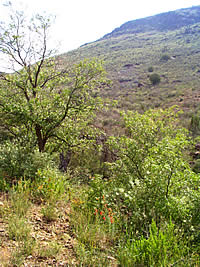
Wildflowers in the Davis Mountains.
The lush vegetation in the mountains of the Trans-Pecos
provides a stark and welcome contrast to the Chihuahua
desert.
Photo by Susan Dial.
Click images to enlarge
|

Traces of different cultures: artifacts
from the Polvo Site, located downstream from the confluence of the Rio Grande
and Río Conchos—La Junta de los Ríos.
The area was inhabited by Patarabueye/Jumano Indians
from about 1200 to 1400 and later by Spaniards and Mexicans.
Drawing from Cloud et al., 1994, courtesy of the Texas
Historic Commission. Click for more detail.
|
|
The missionary efforts at La Junta were plagued
by Spanish slavers who captured local Indians and carried
them south to work in the silver mines.
|
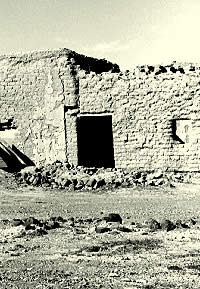
Ruins of freighter Ben Leaton's trading post, established
near La Junta in the 1840s. Called Fort Leaton, it was
not an army post but a family fortress and trading post,
providing shelter and sustenance to travelers between
Eagle Pass and El Paso. The adobe compound has now been
restored by Texas Parks and Wildlife. Photo, TARL Archives.
|
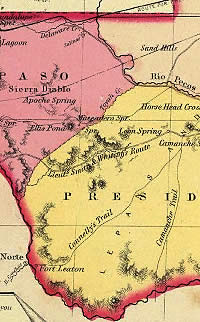
Far west Texas, showing Presidio del
Norte and confluence of the Rio Grande and Rio Conchos.
Lt. Smith's and Whiting's road and Connelly's routecrosses
the Comanche trail near Comanche Springs. Slightly to
the northeast is Horsehead Crossing, the flat, shallow
ford where hundreds of wagons crossed the Pecos River.
Inset of map by G. W. Colton, 1856, courtesy of the
David Rumsey Map Collection. Click to enlarge.
|

Emigrants bound for California crossing the Pecos River
at Horsehead Crossing, west Texas, circa 1850. |
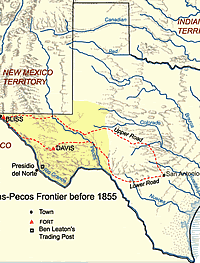
Emigrant routes across the vast open
spaces of the Trans-Pecos frontier are clearly shown
in this map.
|
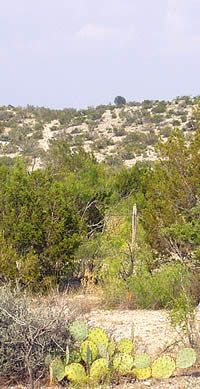
Traces of the old stagecoach road
from San Antonio to El Paso are dimly visible as a light
vertical streak descending from a gap in the hills above
Fort Lancaster. The ride over stony hills was treacherous
enough; stops along the way, amid cactus and mesquite
scrub, was often worse. As one 1850s traveler wrote
of the Trans-Pecos: "One of the most remarkable
features of this inhospitable region is the hostility
with which every plant bears arms… ." Photo by Susan Dial.
|
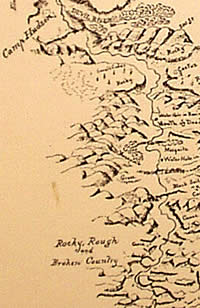
"Rocky, rough and broken country…." Inset
of Topographical Sketch of the Road from Fort Clark to
Fort Stockton, 266 miles, October to November, 1867; and
camps of Bvt. Lt. Col. A. J. Strong. Camp Hudson is shown
at top, midway between Forts Clark and Davis. Courtesy
Fort Stockton Historical Museum. |
|

